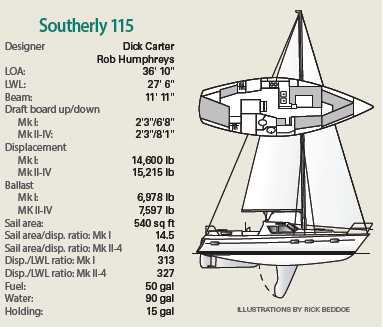
Because its generous beam gives it high form stability, the Southerly 115 achieves good windward performance without excessive heel.
A true shoal-draft cruiser from the UK
When you are used to sailing a performance cruiser with a 7-foot draft, the prospect of spending winters in the shallow waters of Southwest Florida can be daunting. That was the dilemma facing Chris and Laura Mlynarczyk, who enjoy summers aboard their German Frers-designed Swan 40, Allegro, on Lake Michigan. They were concerned that a boat capable of meeting Florida’s draft requirements would be a less satisfying platform, but they found an answer in 2017 when they purchased their 2006 Southerly 115 Mk IV, Blue Sky. In March 2018, my wife, Sandy, and I met Chris and Laura aboard Blue Sky at Burnt Store Marina in Charlotte Harbor on Florida’s west coast.
Chris, a Chicago-area native, was drawn to sailing at an early age when he saw the movie Mutiny on the Bounty. He became a classical guitarist, performing and teaching as he earned his MBA. During this time he took up sailboarding, and eventually he served as crew in three Chicago-Mackinac races. He owned an IOR Half Ton raceboat while in Chicago. After moving to Southern California, where he spent six years, he gained experience on a variety of boats, including Santa Cruz race-boats and J/40s, and sailed a Transpac race aboard a TP52. He spent the next several years in Dubai, and after his return to Chicago sailed a Baltic 35.

Blue Sky’s swing keel draws 8 feet. The bow thruster was standard on Mk IV models of the Southerly 115.
During this time, Chris met Laura. When they found their Swan 40, they knew it was the boat for them and they brought Allegro home to Racine, Wisconsin. Because of her growing love for sailing, Laura suggested they could use a second boat for winter sailing. Adding the Southerly 115 as their Florida boat made an ideal sailing situation for them.

The foredeck on the Southerly 115 is furnished with heavy stainless steel cleats atop the bulwarks port and starboard, and a windlass and substantial Samson post inside the anchor locker.
Design
Northshore Yachts of Chichester, England, began producing the Southerly line in 1975 with the introduction of the Southerly 28. It was designed for true shoal-draft sailing and had to be able to dry out in the tidal estuaries around the United Kingdom while retaining good stability and performance qualities.
When looking for a reliable and sturdy design for larger shoal-draft cruisers, Northshore turned to Carter Offshore, a Boston-area design firm known mainly for IOR raceboats. In 1980, the company introduced the Dick Carter-designed Southerly 95, followed in 1983 by the Southerly 110, which evolved into the 37-foot Southerly 115 with more interior space and a center cockpit.
The first version of the Southerly 115, referred to as the Mk I, had a drop keel in the shape of a triangular airfoil and a single shallow rudder to match the keel-up draft. That rudder showed a tendency to ventilate as the boat heeled under certain conditions, so Northshore had British designer Rob Humphreys modify the 115 and introduced it as the Mk II. Humphreys is known for many successful designs, including Dame Ellen MacArthur’s Open 60, Kingfisher.

One trade-off with the center-cockpit design is that the cockpit seating, at just under 6 feet long, does not allow taller crew to stretch out fully for napping. The seats have inlaid teak and there is locker stowage beneath the starboard one. A recess to starboard of the helm houses the engine controls. Lewmar 44 primary winches are mounted on the coamings, and cubbies beneath them provide stowage for winch handles and other loose items.
Under Humphreys’ direction, Northshore modified the drop keel to provide greater depth and lift, and fitted twin rudders to maintain shallow draft and provide directional control when the boat heeled. Further modifications made in the following years resulted in the Mk III and Mk IV. These modifications were above the waterline and did not affect sailing qualities. The Southerly 115 remained in production until around 2007. Between 250 and 300 hulls were produced.
Northshore Yachts was recently acquired by Discovery Yachts Group, which now produces a line of larger shoal-draft Southerly Yachts in Southampton, England.

Catbird seats built into the stern rail provide an excellent view for backseat drivers.
Construction
The Southerly 115 has a solid hand- laid-up fiberglass hull below the water- line. The topsides and the deck are cored with balsa except in load areas, where plywood core was substituted. The hull and deck are joined at the top of a bulwark with a through-bolted flange that was also chemically bonded. A teak rail caps the joint.
Internal ballast for the Mk I was a cast-iron “pancake” weighing 4,962 pounds. The hydraulically operated 2,016-pound iron swing keel brought the total ballast to 6,978 pounds and provides added righting moment when down. The Humphreys modifications for the Mk II and later models added weight to the keel, raising the ballast figure to a total of 7,597 pounds.
A fiberglass floor and furniture pan also covers the swing keel well; a separate fiberglass headliner finishes the overhead.

Hatches are fitted to port and starboard aft on the forward cabintop and there is a solar vent on the starboard side, above the head. The companionway hatch slides into a sea hood and lines from the mast are led through deck organizers along both sides of the sea hood and aft to the cockpit.
Rig
The rig is a deck-stepped Seldén double-spreader aluminum mast supported by a compression post in the cabin. A single chainplate anchors the upper and intermediate shrouds on each sidedeck; lowers attach to a separate chainplate aft. The wide cabin trunk restricts sidedeck space, but because the chainplates are all inboard toward the cabin trunk, there is adequate width for crew to pass outboard of the shrouds. The backstay is single from the masthead but splits above the stern to connect to port and starboard chainplates. A simple block and tackle allows the backstay tension to be adjusted. The Seldén boom has internal reefing lines and is fitted with a Seldén rigid vang.
There is a Lewmar halyard winch on the port side of the mast, and convenient foldout steps on each side for use when working at the mast.

Large windows on each side of the cabin trunk and along the sloping front surface provide lighting below and excellent views to the exterior. The forward cabintop is low and uncluttered, with only the forward hatch and a single Dorade vent to interfere with crew work.
On deck
Most center-cockpit boats are 40 feet or larger, but the configuration aboard Blue Sky works surprisingly well and does not seem cramped. When we stepped on board, the first thing we noticed was the wide, spacious aft-cabin roof behind the cockpit. The only fixture on it is the hatch over the aft berth.
The steering system is cable-and quadrant by Whitlock. Controls on the pedestal include the system for raising and lowering the keel and, on Blue Sky, the joystick for the bow thruster that was included in the late Mk IV models. A table is fitted to the pedestal.
The teak-capped raised bulwarks enhance safety on deck. Stainless steel stanchions and double lifelines are mounted just inboard of the rail. A gap in the bulwark amidships allows a fair lead for docklines to a convenient mooring cleat.
A large hatch covers the anchor locker and windlass, and when it’s closed the foredeck is relatively clear of obstructions. A single anchor roller is fitted to starboard of the stem fitting, and a short stainless steel sprit to port of the stem fitting allows the tack of an asymmetric spinnaker to be set forward of the headstay.

Over-and-under berths in the forward cabin are a good arrangement for families.
Accommodations
Belowdecks, the interior is richly finished, with teak ceiling along the hull and well-made joinery throughout. Forward, instead of a cramped V-berth, the Southerly 115 has an over/under configuration with two comfortable single berths. Portlights on each side and the overhead hatch provide light and ventilation.

The focus of the saloon, a step down from the galley and nav area, is the wraparound dinette which is partially closed off on the inboard side by the keel trunk.
The saloon is spacious. It’s a small step down from the V-berth and has good headroom beneath the raised cabintop. A U-shaped settee to port surrounds a table supported on the compression post; a settee to starboard completes the seating. Small shelf areas outboard of the seatbacks provide some storage. Two small fixed windows in the hull on each side above the settees augment the ample light provided by the cabin-trunk windows.
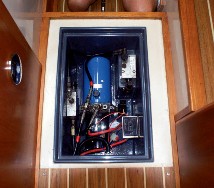
The hydraulic system necessary to raise and lower the heavy lifting keel is under the cabin sole.
A step up from the saloon leads to the navigation station to starboard and the galley to port. The keel trunk is cleverly incorporated into the interior to minimize interference. It begins just aft of the compression post and rises to join with the galley counter area. The hydraulic mechanism for raising and lowering the keel is located beneath the sole here and is easily accessible.
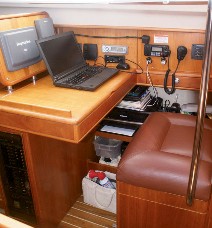
In the navigation station instruments and charts are close at hand.
The roomy nav station has a large chart table with a raised panel for repeater instruments and space along the starboard hull for radios and other accessories. An auxiliary helm was fitted on some earlier models.

Solid fiddles and the sea rail on the cabinet faces are the mark of a seagoing galley where a cook can feel secure. A top closure over the stove provides additional counter space when the stove is not in use.
The L-shaped galley, which lies forward of the companionway to port, has ample countertop space. Drawers are fitted aft of the stove, a front-opening refrigeration compartment is located next to the stove, and lockers beneath the athwartships countertop extend inboard to the keel trunk amidships. A sea rail along the counter edge is a good safety feature. There’s also a two-basin sink with a teak cover, a raised shelf with recesses for cups and mugs, and storage with sliding smoked-acrylic doors.

The electrical panel is beneath the chart table facing the aisle and behind a smoked-acrylic door panel that prevents inadvertent contact with the switches.
Chris has made clever use of the space beneath the raisable companionway ladder by fitting brackets to hold heavier tools and other equipment that might be needed in an emergency.

A nearly king-size berth dominates the aft stateroom and is flanked to port by a dressing seat. Stowage areas are provided under the berth and beneath the overhead under the aft deck. For light and ventilation, there are deadlights in both sides of the hull and opening portlights in the raised deck section above the berth.
Aft, a small step up leads to the prominent feature of the interior, a spacious and comfortable owner’s stateroom with a berth that’s nearly king-size.
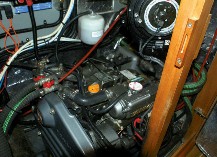
The first Southerly 115s were equipped with the 36-horsepower Bukh diesel engine. Later models, including Blue Sky, were fitted with the Yanmar 3JH4E. Access is provided by doors in the aft passageway and by removable panels.
Under power
When we left the slip, we noted no pronounced prop walk in reverse. As we proceeded through the channel and out into Charlotte Harbor, the throttle control was precise and there was little or no vibration. The engine compartment has decent sound attenuation; cockpit conversations could be carried on in a normal tone. Once we reached the harbor, Chris throttled up to head for deeper water to drop the keel, and still the noise level was not high.
As a Mk IV model, Blue Sky came equipped with a bow thruster controlled by a joystick on the helm pedestal. That makes maneuvering into the slip a piece of cake, even in a crosswind as we experienced.
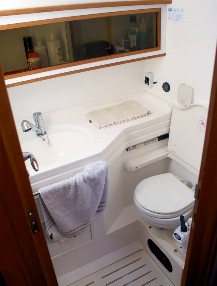
The head compartment is to starboard of the companionway, accessed through a teak door. It doubles as the shower, but the fiberglass moldings are easy to wipe dry. The marine toilet is aft, facing forward.
Under sail
We had two days of nearly ideal conditions on Charlotte Harbor to photograph and sail Blue Sky. On the first day, Sandy and I took out our own Tartan 37, Higher Porpoise, and observed Chris and Laura sailing Blue Sky for the camera. We were not disappointed. Blue Sky seemed to revel in the 10- to 12-knot breeze, and her appearance under sail was striking. This is a very attractive boat with nice lines and good proportions. Frankly, we did not expect that of a 37-foot center-cockpit boat. She sailed past us close-hauled, on a reach, and on a run. In each case, she was under control and seemed solid and stable.
On day two, Sandy and I went aboard Blue Sky to sail her with Chris and Laura. Once we were in deeper water, Chris lowered the keel and raised the sails. The hydraulic system makes lowering and raising the keel quick and easy; a display at the helm helps in assessing the keel depth.
There was enough breeze to move Blue Sky smartly, and we took advantage of the conditions to assess her performance. Going to windward on port tack, we sailed to 35 degrees apparent wind. We were doing 5.5 knots and control seemed precise. I needed only a light touch on the wheel to counteract the desired slight weather helm. We came about and found similar performance on the starboard tack. The dual rudders provided good control throughout. (We have had no opportunity to sail a Mk I model with the single rudder for comparison.)
On a beam reach we were making just over 6 knots, and control was again smooth and precise. We did not experience sea conditions that might have caused problems for the shallow rudder system, but I suspect the twin rudders used on the Mk II model and up would likely perform well with the leeward rudder fully immersed.
Bearing off onto a run, the boat exhibited good control and stable tracking with no apparent roll. All in all, the boat performed in a manner similar to a fixed-keel boat. It is a platform that can provide decent sailing performance and yet still allow access to many areas that deeper-draft boats cannot reach.
The majority of the Southerlys are in Europe, and because they have not been raced much here in the US, no published PHRF ratings are available. Only a few IRC ratings are available from European sources, and based on those and comparisons with other boats, the Southerly 115 would likely carry a PHRF rating of 145 to 155, compared to a Catalina 36 at 147 or an Islander 36 at 144.
Prices and availability
As noted above, there are few Southerly 115s in the US, but they do occasionally become available, as Chris and Laura found, and it is worth keeping an eye on the market.
Many of the boats we saw listed were older Mk I models. Converted to US dollars, their prices ranged from $46,500 for a 1987 model in Greece to a 1985 model in the UK for $79,000. A newer Mk III model was available in Germany for $138,000. It would be necessary to factor in transportation costs or the cost of a passage if considering purchasing a Southerly 115 in Europe.
Resources
The Southerly 115 is no longer in production, but the website for SoutherlyYacht Services remains live and offers spare parts, even after the acquisition of Northshore by DiscoveryYachts: southerlyyachtservices.com/spare- parts
A good summary of the design aspects of the Southerly 115 may be found atYachtsNet: yachtsnet.co.uk/archives/ southerly-115/southerly-115.htm


